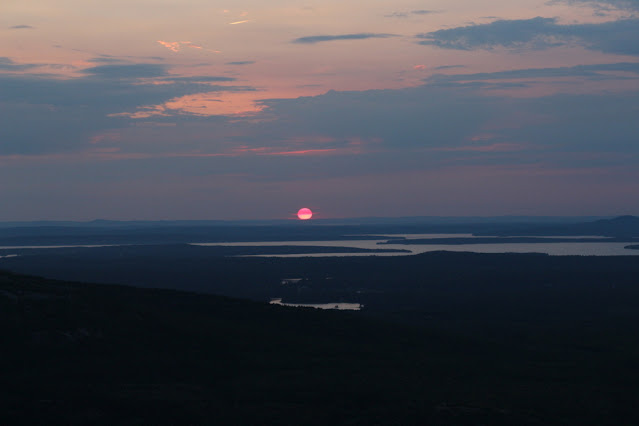We spent this week at Acadia National Park on Mount Desert Island in downeast Maine. Acadia is one of the smallest national parks, containing only 49,000 acres compared to Yellowstone for example, which is 2.2 million acres. Yet its beauty attracts 4 million visitors each year, more than even Yellowstone, making Acadia the fifth most visited of all our national parks.
 |
| The east shore of Mt. Desert Island. |
The number of people in the park means there isn't a lot of wildlife to be seen, but in quiet corners of the island outside the park we did find a few enjoyable sightings. My favorite was a Seal.
 |
| A Gray Seal in the Mr. Desert Narrows. |
Most often I've seen Harbor Seals in Maine, but this one was very large, so I think it was a Gray Seal which can weight up to 800 pounds. We didn't see any seals in either Seal Cove or Seal Harbor; we saw this seal in a section of The Narrows on the far west side of Mt. Desert Island (known as "the quiet side").
 |
| Seal Cove on the Quiet Side. |
Avian sightings included immature Eiders (I think), Ring-billed Gulls, and a New Hampshire favorite, a Pileated Woodpecker.
 |
| Eiders in Compass Harbor |
We found the woodpecker and eiders on a quiet walk to Compass Harbor, just outside Bar Harbor. (Thanks for the suggestion AW!)
We also saw a pretty monarch butterfly still lingering way up in northern Maine.
And with this gorgeous weather I don't blame it for delaying the start of its long journey to Mexico.
What the National Park lacks in wildlife is made up for with its rugged beauty and geology.
 |
| The Otter Cliffs. |
The area must be a paradise for geologists. Volcanic activity and the forces of shifting tectonic plates created cliffs of gorgeous pink granite and huge sections of the Earth's crust tilted up to almost vertical. Then there is a random marbled rock of metamorphic quartz and feldspar haphazardly deposited on a shoreline.
 |
| At 500 million years old, this type of rock is oldest on Mt. Desert Island. |
And amid all these rocky shorelines, there's a beautiful sand beach with aquamarine water.
 |
| "Sand Beach" seen from Great Head. |
 |
| View over Frenchman Bay from the top of Mt. Champlain. |
It's unusual in New England to have this distant a horizon to watch the sun set behind.
Upon returning home to Lake Wicwas we were immediately greeted by one of our resident loons which is still here maintaining rights to its nesting territory. It took a while, but I eventually was able to catch a glimpse of its band verifying it's the male of the north nesting territory.
 |
| White band, black dot. |
We were also pleased to see that even with only 0.15" of rain since mid-August the lake is still at nearly full level, helped by the beavers having impounded two large ponds which feed the lake with a constant trickle of water no matter how hard the beavers work to plug every leak.
We didn't see beavers on Mt Desert Island but we did see their signs around Jordan Pond.
 |
| A beaver Lodge up the stream that fills Jordan Pond. |
It's easy to see why this small park has more annual visits than Yellowstone.








No comments:
Post a Comment